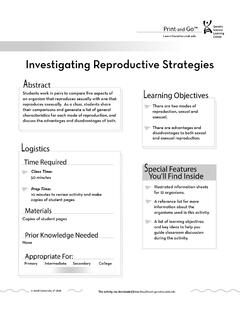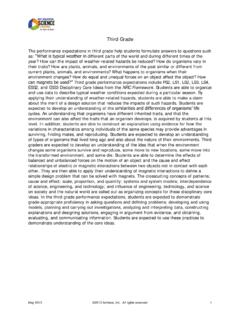Transcription of World Health Organization reference values for human …
1 human Reproduction Update, , pp. 231 245, 2010. Advanced Access publication on November 24, 2009 World Health Organization reference values for human semen characteristics* . Trevor G. Cooper 1,10, Elizabeth Noonan 2, Sigrid von Eckardstein3, Jacques Auger 4, Gordon Baker 5, Hermann M. Behre6, Trine B. Haugen 7, Thinus Kruger 8, Christina Wang 9, Downloaded from at World Health Organization on April 20, 2012. Michael T. Mbizvo3, , and Kirsten M. Vogelsong 3, . 1. Centre of Reproductive Medicine and Andrology of the University, Domagkstrasse 11, D-48129 Mu nster, Germany 2 Fred Hutchinson Cancer Research Center, SCHARP Statistical Center for HIV/AIDS Research and Prevention, Seattle, WA, USA 3 UNDP/UNFPA/WHO/.
2 World Bank Special Programme of Research, Development and Research Training in human Reproduction (HRP), Department of Reproductive Health and Research, WHO, CH-1211 Geneva 27, Switzerland 4 Service d'Histologie-Embryologie, Biologie de la Reproduction/CECOS, Pavillon Cassini, Ho pital Cochin, Paris, France 5 Department of Obstetrics and Gynaecology, University of Melbourne, Royal Women's Hospital, Carlton, VIC, Australia 6 Center for Reproductive Medicine and Andrology, University Hospital Halle, Martin Luther University, Halle, Germany 7 Faculty of Health Sciences, Oslo University College, Oslo, Norway 8 Reproductive Biology Unit, Stellenbosch University, Tygerberg.
3 South Africa 9 Harbor-UCLA Medical Center and Los Angeles Biomedical Research Institute, Torrance, CA, USA. 10. Correspondence address. Tel: 49-251-835-6449; Fax: 49-251-835-6093; E-mail: table of contents .. Introduction Materials and Methods Study populations Analytical methods and quality control Identi cation of data and handling of the datasets Statistical analysis Results Ages of men providing semen samples reference values for human semen Statistical differences in semen characteristics among the various populations Discussion Choice of reference limits Comparison of the current with published reference limits Comparisons of semen characteristics among different populations of men Signi cance of lower reference limits Limitations of the current reference values background.
4 Semen quality is taken as a surrogate measure of male fecundity in clinical andrology, male fertility, reproductive toxi- cology, epidemiology and pregnancy risk assessments. reference intervals for values of semen parameters from a fertile population could provide data from which prognosis of fertility or diagnosis of infertility can be extrapolated. *Dedicated to the memory of Professor GMH Waites (1928 2005). These authors ( , ) are staff members of the World Health Organization . The authors alone are responsible for the views expressed in this publication; these views do not necessarily represent the decisions or policies of the World Health Organization .
5 The list of authors who contributed data to this study is given in the Appendix. & World Health Organization [2009]. All rights reserved. The World Health Oragnization has granted Oxford University Press permission for the reproduction of this article. 232 Cooper et al. methods: Semen samples from over 4500 men in 14 countries on four continents were obtained from retrospective and prospective analyses on fertile men, men of unknown fertility status and men selected as normozoospermic. Men whose partners had a time-to- pregnancy (TTP) of 12 months were chosen as individuals to provide reference distributions for semen parameters. Distributions were also generated for a population assumed to represent the general population.
6 Results: The following one-sided lower reference limits, the fth centiles (with 95th percent con dence intervals), were generated from men whose partners had TTP 12 months: semen volume, ml ( ); total sperm number, 39 million per ejaculate (33 46); sperm concentration, 15 million per ml (12 16); vitality, 58% live (55 63); progressive motility, 32% (31 34); total (progressive non- progressive) motility, 40% (38 42); morphologically normal forms, ( ). Semen quality of the reference population was superior to that of the men from the general population and normozoospermic men. conclusions: The data represent sound reference distributions of semen characteristics of fertile men in a number of countries.
7 They provide an appropriate tool in conjunction with clinical data to evaluate a patient's semen quality and prospects for fertility. Key words: human semen / reference values / infertility diagnosis / fertile men Downloaded from at World Health Organization on April 20, 2012. cut-off limits separating fertile from infertile populations, doubts Introduction have been raised about the validity of this approach (Bartoov et al., The WHO manual for the examination of human semen and 1993; Barratt et al., 1995). sperm[semen]-cervical mucus interaction' (WHO, 1987, 1992, 1999) This article considers which men are most suitable for providing a is widely used as a source of standard methodology for laboratories reference population, presents data from such a population, mentions engaged in semen analyses.
8 However, the interpretation and appli- the possible limitations of the results obtained and discusses how the cation of previous WHO normal' or reference ' values for semen par- reference intervals could be interpreted as useful reference limits. The ameters used thus far have limitations, since the data were derived present analysis bene ts from the availability and incorporation of from imprecisely de ned reference populations and obtained from multi-country data from recent fathers with known time-to-pregnancy laboratories with unknown comparability with respect to analytical (TTP). The development and application of clear reference ranges methodologies.
9 These values were limited by the lack of available should help reduce the incidence of misdiagnosis of fertility problems data on semen variables in recent fathers, and did not de ne true and improve clinical care. reference ranges or limits. There has been no consensus around the Individuals considered suitable for providing reference semen values suitability of these values , as some centres consider the cited values have included unselected populations, that is, men of unproven fertility for characteristics of sperm concentration, morphology and motility (Irvine et al., 1996; Paulsen et al., 1996; Lemcke et al., 1997; Junqing too high, whereas others consider them too low.)
10 Et al. 2002); men from couples presenting with infertility (MacLeod If too high, a high percentage of fertile men would be classi ed as and Wang, 1979; Bostofte et al., 1983; Berling and Wolner-Hanssen, subnormal, especially when morphology, sperm concentration or 1997; Andolz et al., 1999); candidates for semen donation, some motility is considered (Barratt et al., 1988; Chia et al., 1998; Nallella proven fertile (Leto and Frensilli, 1981; Auger et al., 1995; Bujan et al., 2006; Pasqualotto et al., 2006; Gao et al., 2007, 2008). et al., 1996; Van Waeleghem et al., 1996) and men presenting for Healthy men may also be investigated for infertility, or inappropriately vasectomy (Sultan Sheriff, 1983; Fisch et al.
















